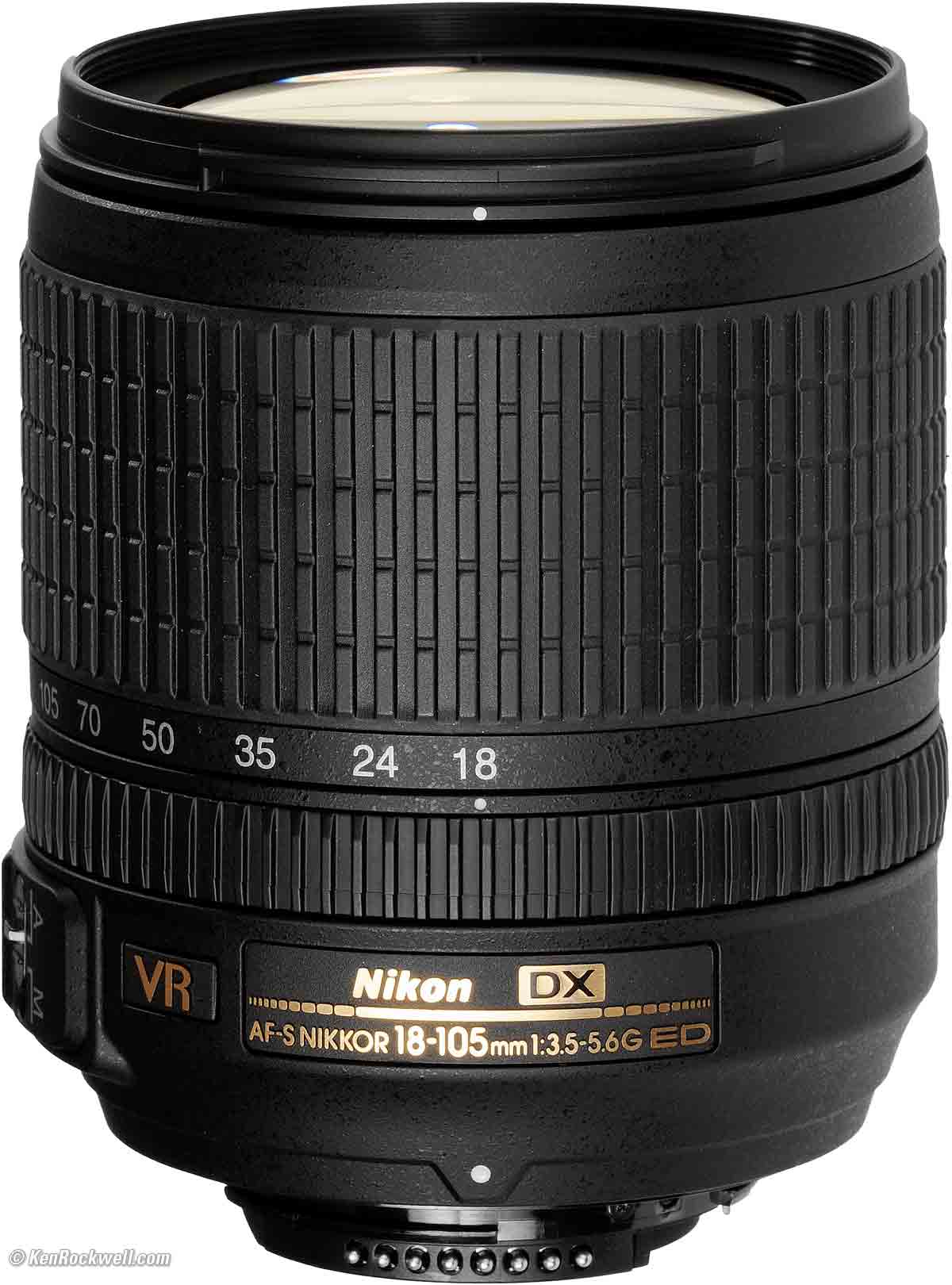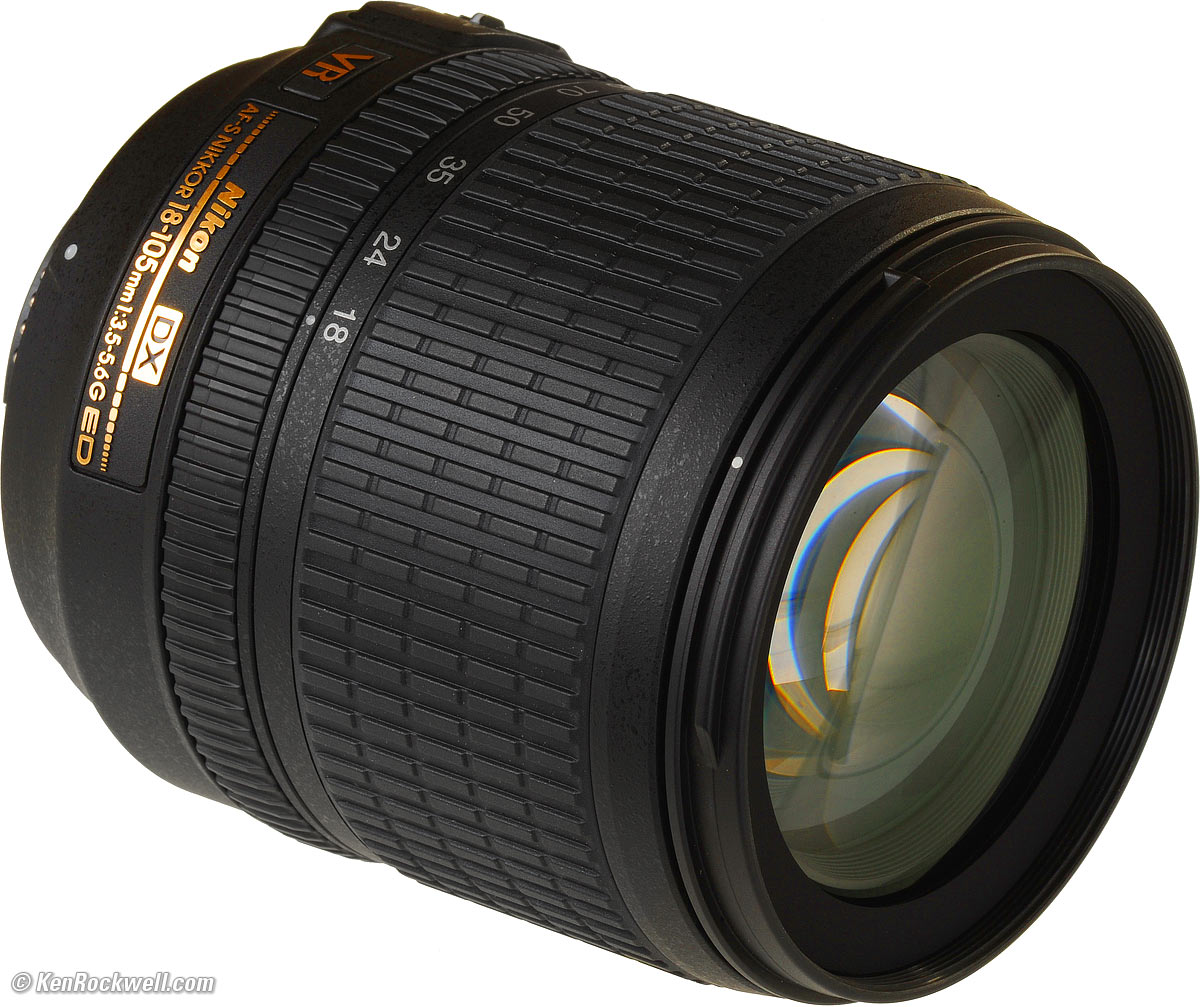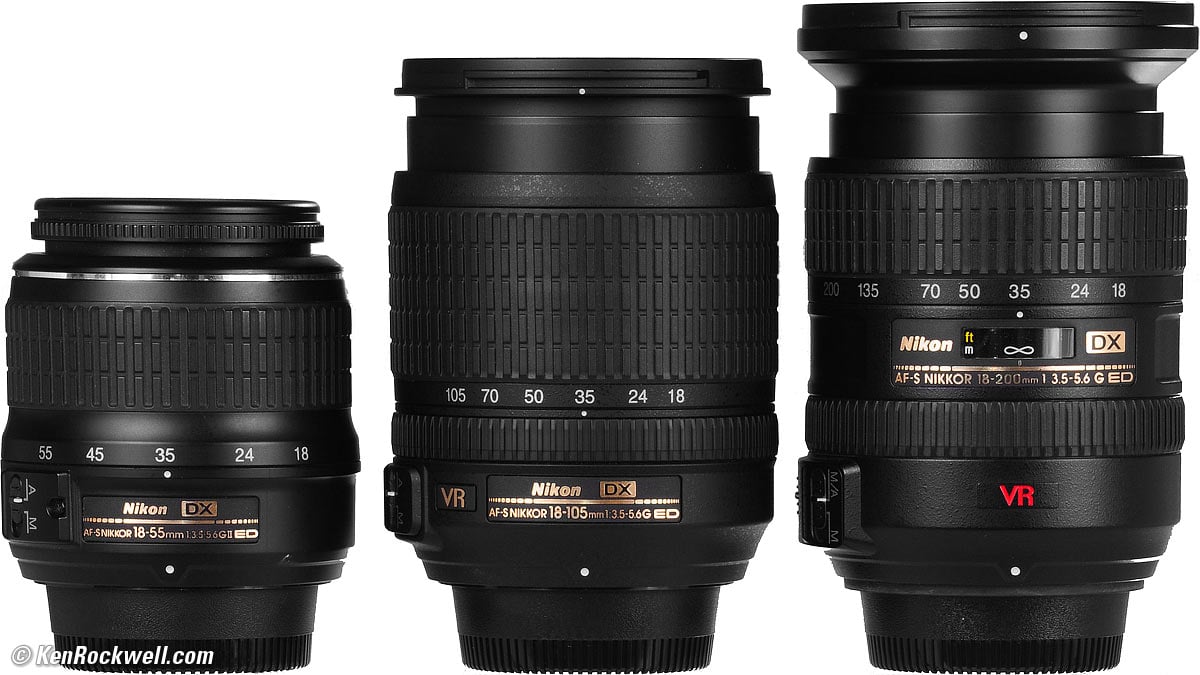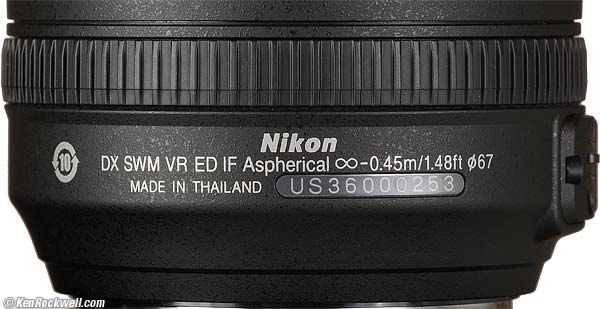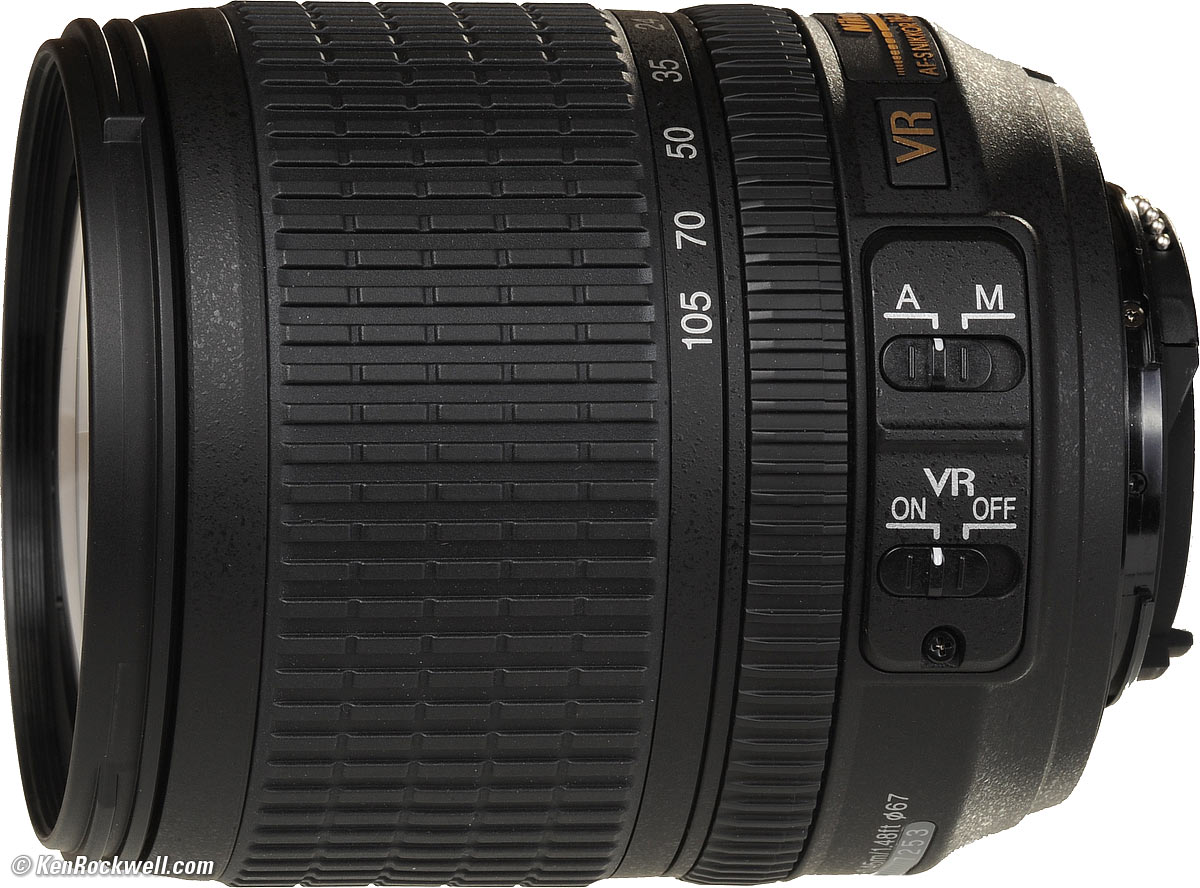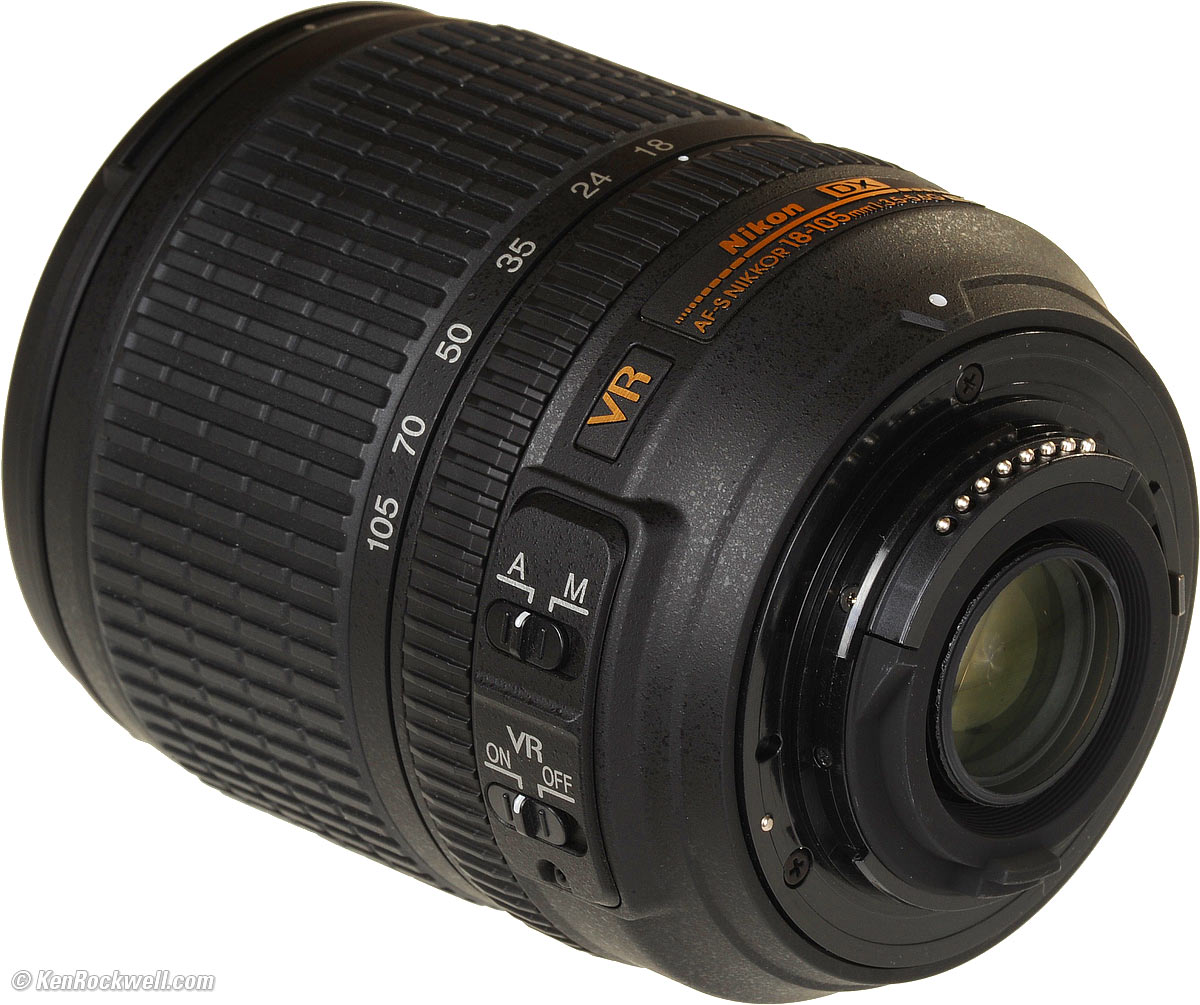Home Donate New Search Gallery How-To Books Links Workshops About Contact
Nikon 18-105mm VR DX
Nikon 18-105mm f/3.5-5.6 VR DX (67mm filters, 14.8 oz./420g, 1.5'/0.45m close focus, about $397). bigger. I'd get mine at Adorama , at Amazon or at B&H.
This all-content, junk-free website's biggest source of support is when you use those or any of these links to my personally-approved sources when you get anything, regardless of the country in which you live. Nikon does not seal its boxes in any way, so never buy at retail or any other source not on my personally approved list since you'll have no way of knowing if you're missing accessories, getting a defective, damaged, returned, non-USA, store demo or used lens. Get yours only from the approved sources I use myself for the best prices, service, return policies and selection. Thanks for helping me help you! Ken.
March 2018 Nikon Reviews Nikon Lenses Nikon Flash All Reviews
Ideal Uses: General-purpose plastic zoom for use on DX digital cameras.
Not for: Film or FX cameras.
|
I buy only from these approved sources. I can't vouch for ads below. |
Introduction top
Intro Specs Performance Recommendations
The plastic-mount 18-105mm VR is a decent enough general-purpose lens for people who are in the price range of the D90 with which it is kitted, but for $400 ($300 in a kit with the D90), I'd rather buy something else.
The photos are nice and sharp most of the time, but if you're looking closely, the 18-105mm is Nikon's fuzziest lens in the corners at 18mm. Even the $100 18-55mm is better.
For $400, you could buy either of the excellent 18-55mm kit lenses which are sharper at 18mm (VR or non-VR, your choice), and with the money left over, buy the professional 50mm f/1.4 AF-D or 50mm f/1.8 AF-D for use in low light, all for the same price or less than the 18-105mm.
For not much more, I could get the superior metal-mount 16-85mm VR or 18-200mm VR instead, either of which is also superior to the 18-105mm.
The only DX midrange zoom I like less than this 18-105mm is the non-VR 18-135mm, which is also overpriced.
Nikon 18-105mm. enlarge.
Compatibility back to intro back to top
Everything works perfectly on every DX digital Nikon.
Forget it for film, because you'll get black corners, and it's silly to use it on an FX camera because you'll only be using the middle of your very expensive sensor.
See Nikon Lens Compatibility for details with your camera. Read down the "AF-S, AF-I," "G" and "VR" columns for this lens. You'll get the least of all the features displayed in all columns, since "G" (gelding) is a handicap which removes features.
DX Lens History back to intro back to top
2003: The first DX lens is the 12-24mm, followed by the 10.5mm fisheye and 17-55mm f/2.8. None of these has VR.
2004: 18-70mm f/3.5-4.5, metal mount. It has no VR.
2005 April: 18-55mm f/3.5-5.6, and 55-200mm f/4-5.6. Both are plastic mount and have no VR. The 18-55 doesn't need VR, but telephotos often do.
2005 November: 18-200mm f/3.5-5.6 VR, metal mount.
2006: 18-135mm f/3.5-5.6, plastic mount. It needs VR but doesn't have it.
2007: 18-55mm f/3.5-5.6 VR, and 55-200mm VR, both in plastic mount.
2008 January: 16-85mm f/3.5-5.6 VR, metal mount.
2008 August: This 18-105mm VR, plastic mount, is announced.
All are still in production as of September 2008
Nikon 18-55mm II, this 18-105mm VR and 18-200mm VR. enlarge.
Specifications top
Intro Specs Performance Recommendations
Gobbledygook, Nikon 18-105mm DX VR.
Name
Nikon calls this the Nikon AF-S DX NIKKOR 18-105mm f/3.5-5.6G ED VR.
AF-S and SWM: Silent Wave (focus) Motor.
DX: Corners black-out on film or FX cameras.
G: Gelded for cost-reduction and removing compatibility with older cameras.
ED: ED Glass.
IF: Internal Focusing. Nothing moves externally when it focuses.
VR: Vibration Reduction.
Optics
15 elements in 11 groups.
One is of ED glass, another is aspherical.
It's multicoated, which Nikon calls Super Integrated Coating (SIC).
Focal Length
18-105mm, which on a DX camera gives angles of view similar to what a 28-150mm lens gives when used on an FX or 35mm camera.
Close Focus
1.5 feet (0.45m).
Maximum Reproduction Ratio
1:5.
Hard Infinity Focus Stop
No.
Focus Scale
No.
Depth-of-Field Scale
No.
Infra-Red Focus Index
No.
Diaphragm
7 rounded blades.
Stops down to f/22 at 18mm and f/38 at 105mm.
Aperture Ring
No.
Tripod Collar
No.
Filter Thread
67mm, plastic. Does not rotate.
Size
3.5" (89mm) extension from flange by 3.0" (76mm) diameter.
Weight
Nikon specifies 14.8 oz. (420g).
Hood
HB-32 plastic bayonet, included (at least in Japan).
Case
CL-1018 pouch, included.
Introduced
27 August 2008, along with the D90.
Shipping Since
Mid-September, 2008 (USA).
Price
March 2018: $397, USA.
2008: $399, USA; 249€ Europe. ($300 as a kit with the D90).
Performance top
Intro Specs Performance Recommendations
Overall Focus Distortion Ergonomics Falloff Filters
Lateral Color Fringes Macro Maximum Aperture
Mechanics Sharpness VR Zooming
Overall back to Performance back to top
The 18-105 VR works as expected, but it's soft in the corners at 18mm if you're looking.
If you're a serious photographer who worries about corner sharpness for landscapes, pass on the 18-105mm. Most people would never notice.
Focus back to Performance back to top
Nikon 18 105 controls. enlarge.
Auto Focus
AF isn't that fast. It's not a speed demon like the pro AF-S lenses.
Manual Focus
Manual focus is easy: just grab the focus ring at any time. You don't need to take the A-M switch out of Auto.
Distortion back to performance back to top
The 18-105 has the usual complex barrel distortion at 18mm, and pincushion distortion throughout most of the rest of the range, of modern wide-ratio zooms.
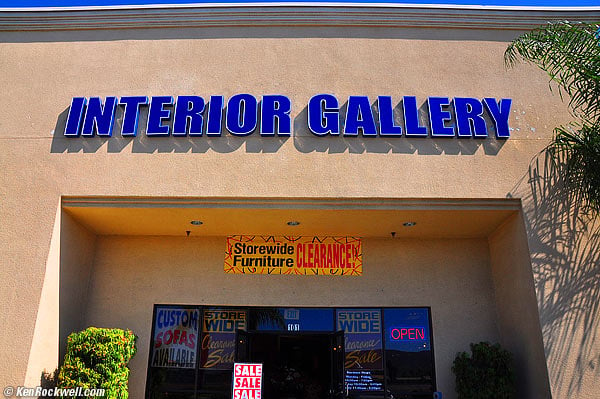
Distortion at 18mm (DX camera).
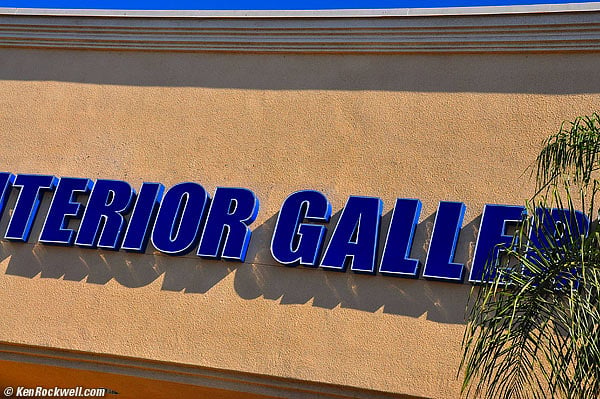
Distortion at 50mm (DX camera).
This can be corrected for critical use by plugging these figures into Photoshop CS2's lens distortion filter. These aren't facts or specifications, they are the results of my research that requires hours of photography and calculations on the resulting data.
On DX |
Visible Effects |
|
18mm |
strong barrel (bulging) |
+4.0* |
21mm |
neutral but wavy |
0.0* |
24mm |
pincushion |
-2.2 |
35mm |
strong pincushion (sucking) |
-3.5 |
50mm |
strong pincushion (sucking) |
-4.0 |
105mm |
strong pincushion (sucking) |
-3.0 |
© 2008 KenRockwell.com. All rights reserved.
*Waviness remains
Ergonomics (handling and ease-of-use) back to performance back to top
The ergonomics are great. Nothing gets in the way of great pictures.
Focus is easy to override, and the zoom range is well spread out.
Your hands will naturally fall on the zoom ring, and not easily hit the focus ring by accident as is a problem with the $1,600 24-70mm f/2.8.
Falloff (darkened corners) back to performance back to top
Falloff on DX isn't a problem.
I've exaggerated this by shooting a gray field and placing these on a gray background.
Nikon 18-105mm falloff on DX at infinity.
© 2008 KenRockwell.com. All rights reserved.
|
Filters, Use with back to Performance back to top
I see no problems with vignetting with standard, or even thick filters. I wouldn't spend more mooney on thin-mount filters, unless you're going to stack them.
The filter ring does not rotate.
Lateral Color Fringes back to Performance back to top
There are no lateral color fringes when shot on the D90, which would correct them if there were there.
Macro back to Performance back to top
Macro is fine, letting you fill the DX frame with objects as small as about 3 x 4.6" (8 x 12cm).
Maximum and Minimum Apertures Performance top
Maximum |
Minimum |
|
18mm |
f/3.5 |
f/22 |
24mm |
f/4 |
f/25 |
35mm |
f/4.5 |
f/29 |
50mm |
f/5 |
f/32 |
70mm |
f/5.3 |
f/36 |
105mm |
f/5.6 |
f/36 |
Mechanics back to Performance back to top
Nikon 18-105 and plastic mount. enlarge.
Barrel Exterior
Plastic.
Filter Threads
Plastic.
Hood
Plastic bayonet.
Focus Ring
Semi-rubbery, semi-hard plastic.
Zoom Ring
Plastic, rubber covered.
Depth-of-Field Scale
None.
Aperture Ring
None.
Mount
Plastic.
Markings
Paint.
Identity Plate
Embossed and planed metal.
Weaknesses
Watch the plastic lens mount; avoid picking up a camera by grabbing the lens since it could break off!
Sharpness back to Performance back to top
Warning 1: Image sharpness depends more on you than your lens.
Warning 2: Lens sharpness doesn't mean much to good photographers.
With those caveats, the 18-105 is probably the softest DX lens I've used in the corners at 18mm.
Otherwise, it's sharp all over, so just don't look closely in the corners at 18mm and it looks great.
At 18mm
It's smeared in the corners wide-open, and doesn't get much better stopped down to reasonable apertures. My sample was worse on one side, but not by much.
At 24mm
It's a bit softer, but not smeared, in the far corners wide open. It gets better stopped down. My sample was a little softer on one side.
At 50mm
It's sharp all over at all apertures.
At 105mm
It's sharp all over at all apertures.
At small apertures like f/16 and smaller, diffraction limits performance.
VR Measurements back to performance back to top
VR (vibration reduction for hand-holding in the dark) is not very good. It only offers one or two stops of real improvement.
By "sharp shots" I mean perfect tripod-equivalent sharpness when viewed at 100%, as shot on a D90 by me. For most uses, one can use much slower speeds. See Why VR Matters for more.
VR OFF
% Sharp Shots |
1 |
1/2 |
1/4 |
1/8 |
1/15 |
1/30 |
1/60 |
1/125 |
1/250 |
18mm |
0 |
0 |
17 |
66 |
100 |
100 |
100 |
100 |
100 |
35mm |
0 |
0 |
5 |
16 |
60 |
70 |
90 |
100 |
100 |
105mm |
0 |
0 |
0 |
0 |
16 |
16 |
50 |
100 |
100 |
VR ON
% Sharp Shots |
1 |
1/2 |
1/4 |
1/8 |
1/15 |
1/30 |
1/60 |
1/125 |
1/250 |
18mm |
10 |
80 |
100 |
100 |
100 |
100 |
100 |
100 |
100 |
35mm |
0 |
10 |
5 |
80 |
100 |
100 |
100 |
100 |
100 |
105mm |
5 |
20 |
25 |
50 |
80 |
100 |
100 |
100 |
Lowest speeds for perfectly sharp shots 50% of the time
VR OFF |
VR ON |
Real Stops Improvement |
Marketing Stops Improvement |
|
18mm |
1/6 |
1/3 |
1.0 |
2.6 |
35mm |
1/15 |
1/5 |
1.6 |
2.8 |
105mm |
1/60 |
1/15 |
2.0 |
2.8 |
"Real Stops" are how many extra stops I get over shooting without VR. "Marketing stops" is improvement over the old-wives' tale of 1/focal length as a lower speed limit.
Hint: VR improves your hit ratio. It doesn't guarantee that every shot will be sharp. I always shoot at least three-shot bursts at slow speeds so I can pick the sharp shot out of several when shooting handheld at really slow speeds.
Zooming back to Performance back to top
Zooming is well spaced, with no part of the range being squashed too close together as many other lenses like the old 18-70mm do.
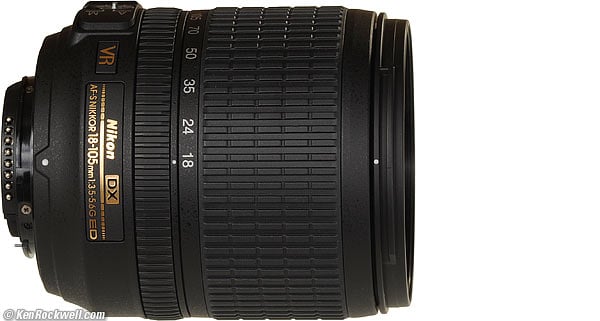
Nikon 18-105mm at 18mm.
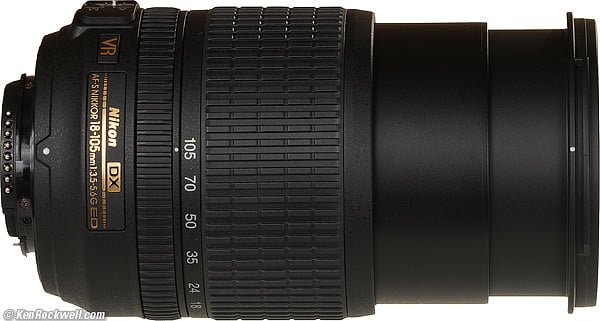
Nikon 18-105mm at 105mm.
Recommendations top
Intro Specs Performance Recommendations
I'd pass on this 18-105mm lens. It's too expensive for what you get. $400 for a plastic mount lens? Not from my wallet, but if you want a light, do-almost everything lens for a DX camera and don't mind the price, this could be your ticket.
I would forget the 18-135mm since it lacks VR.
Personally I love the more expensive 18-200mm VR because it does just about everything. For only about $250 more ($650 total), the 18-200mm VR could be the only lens you ever need.
I prefer both the 18-55mm and 18-55mm VR lenses, which are both sharper and a fraction of the price! I use them when I go on vacation and want light weight. In all honesty, I don't like long lenses. The best photos come from getting close enough, not from throwing more money into a longer lens to shoot from farther away. You can make great portraits with these 18-55 lenses, and geesh, how many head shots do you need anyway? I usually shoot my people pictures at shorter zoom settings than 55mm anyway.
If you insist on soft backgrounds for portraits, none of these zooms does a particularly spectacular job. If you're doing posed portraits, you could use an old manual focus 135mm f/2.8 (about $150 used) or 80-200mm f/2.8 ($900 new) for far better results. See Portrait Lenses for more ideas.
Don't forget the 50mm f/1.8 AF-D and 50mm f/1.4 AF-D, each pro lenses and each much less expensive than this zoom. Each will autofocus on every camera except the D40, D40x and D60, for which you would need the new 50mm AF-S instead.
Deployment
I'd leave either a 67mm Nikon Clear (NC - UV) filter, or a 67mm Hoya Super HMC UV on the lens at all times. I would leave the hood at home.
If I was going to use this as part of a larger pro system, I'd attach a 67->77mm step-up-ring to convert this to today's pro standard of 77mm, and use a 77mm Nikon UV or Hoya UV filter for protection. This is what I really do; I just put on a step-up ring when I get a lens like this and treat it as if it's a 77mm filter thread len as long as I have it.
If you go the step-up route, don't forget a new Nikon 77mm cap.
If I was working in nasty, dirty areas, I'd forget the cap, and use an uncoated 67mm Tiffen UV filter instead (or in 77mm). Uncoated filters are much easier to clean, but more prone to ghosting.
© Ken Rockwell. All rights reserved. Tous droits réservés. Alle Rechte vorbehalten.
Help Me Help You
I support my growing family through this website, as crazy as it might seem.
The biggest help is when you use any of these links when you get anything. It costs you nothing, and is this site's, and thus my family's, biggest source of support. These places always have the best prices and service, which is why I've used them since before this website existed. I recommend them all personally.
If you find this page as helpful as a book you might have had to buy or a workshop you may have had to take, feel free to help me continue helping everyone.
If you've gotten your gear through one of my links or helped otherwise, you're family. It's great people like you who allow me to keep adding to this site full-time. Thanks!
If you haven't helped yet, please do, and consider helping me with a gift of $5.00.
As this page is copyrighted and formally registered, it is unlawful to make copies, especially in the form of printouts for personal use. If you wish to make a printout for personal use, you are granted one-time permission only if you PayPal me $5.00 per printout or part thereof. Thank you!
Thanks for reading!
Mr. & Mrs. Ken Rockwell, Ryan and Katie.

